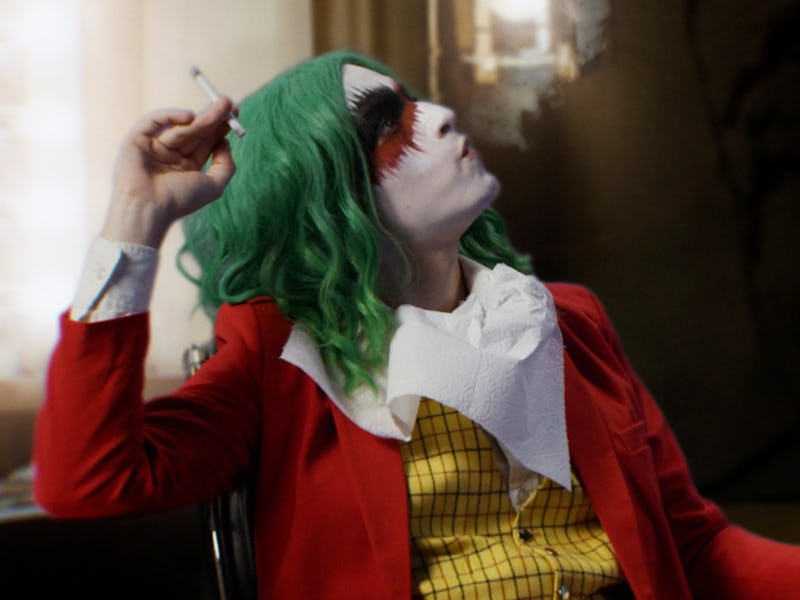The People's Joker Is the Transgressive Superhero Movie We Need and Deserve
She’s the Joker. And she’s a woman of her word.

The People’s Joker accidentally stumbled into a real-life superhero movie plot. A semi-autobiographical, low-budget Joker parody movie borne out of the early days of the pandemic, it became an unlikely underdog in a battle against a fearsome Hollywood titan when Warner Bros. sent a concerning letter that led to the title being pulled right before its Toronto International Film Festival premiere. But two years after The People’s Joker’s very existence was threatened, it has triumphed, with a surprisingly wide release courtesy of distributor Altered Innocence.
But while its behind-the-scenes drama may make a classic superhero story, the actual movie itself is anything but traditional. Its distinct style and coherent worldbuilding make for a movie that can’t really be compared to anything else, despite the fact so much of it is borrowed from the works of Batmen past — and it’s exactly what jaded superhero fans need to witness.
Vera Drew, the writer/director/star/editor, is also the protagonist in a way, telling a semi-autobiographical story of a child who idolized comedians and had strange feelings about gender that she dealt with through antidepressants. But in The People’s Joker, she exists in a world where Batman has abolished all comedy outside the government-sanctioned United Clown Bureau (a stand-in for both Saturday Night Live and the improv education behemoth UCB Theater), and a Scarecrow-esque doctor has prescribed Smylex, a purple gas that erases all negative emotion.
Countless iconic superhero moments are reflected in digital backgrounds in The People’s Joker.
This mishmash of analogs forms the movie’s first act before the autobiography peels away to form a story that would be exciting even in a non-parody movie. Joker the Harlequin, as our protagonist is now known, is the leader of an illegal “anti-comedy” theater along with a rogue’s gallery of fellow alt-comics, including Penguin (Nathan Faustyn) and Mr. J (Kane Distler), a transmasculine Joker styled like Jared Leto in Suicide Squad.
Joker the Harlequin and Mr. J fall in love, and while Mr. J’s dark backstory fuels the villains to team up to take down Batman and UCB once and for all, it also forces Joker to realize just how sick and twisted her life has become. The monologue-style narration throughout the movie provides a blatant, almost stand-up-style structure, while allowing for moments like pausing the film to provide a numbered list of red flags for abusive relationships — red flags she missed with Mr. J.
The People’s Joker isn’t for the faint-of-heart. Almost every shot is presented as live-action actors green-screened onto digital backgrounds, and the action often swaps between live-action and animation without any explanation. And amid all the style changes, it manages to cram in more pop culture references than an entire season of Mystery Science Theater 3000. It fits right in with Drew’s video-collage filmmaking style, but for those who are more used to Zack Snyder fare, it could be jarring. But once you buy into the borderline psychedelic visuals, the brisk 92-minute film wastes no time in delivering a deeply personal, heartbreaking story.
It all culminates in a trans-dimensional (as well as transgender) finale that turns the fever-dream visuals up to 11 with an altered reality that carries through the rest of the movie, all the way up to the last moments. Yes, there are post-credit scenes — scenes, plural — that make the occasionally overwrought scenes about Joker’s mom realizing her cycle of abuse totally worth it.
Animation is used occasionally in The People’s Joker, like during the romantic scenes between Joker the Harlequin and Mr. J.
It can be easy to dismiss The People’s Joker as a movie that hates on the superhero industrial complex, but it equally critiques the “real storyteller” complex that comedians fall under. Lorne Michaels (voiced by the incomparable Maria Bamford) is shoddily animated as a fleshy soulless mannequin, and the UCB “audition bot” judges potential comedians by substance use, need for outside validation, and most of all, sex. Every critique in the dialogue is something that could only be observed by someone who thinks about these topics a lot.
The story makes it very clear that it’s for trans people — you can even buy T-shirts that read “I Watched The People’s Joker Now I’m Trans” — but as much as it’s a movie about the trans coming-of-age experience, it’s also a story about growing up idolizing superheroes and media. How do you form an identity when so much of your life is spent obsessing over fictional worlds or pop culture? How can you figure out who you are when everyone around you is obsessed with being someone else?
They’re questions any self-proclaimed fanboy should be asking, yet they’re often avoided in discussions. The People’s Joker explores these questions in the language of the “people”: superhero movies themselves. As self-critical as it is self-referential, it plays to every trope and visual choice while showing how an all-adoring eye can be dangerous. The superhero movie devotees who most need to watch this probably won’t, but that doesn’t make it any less essential.